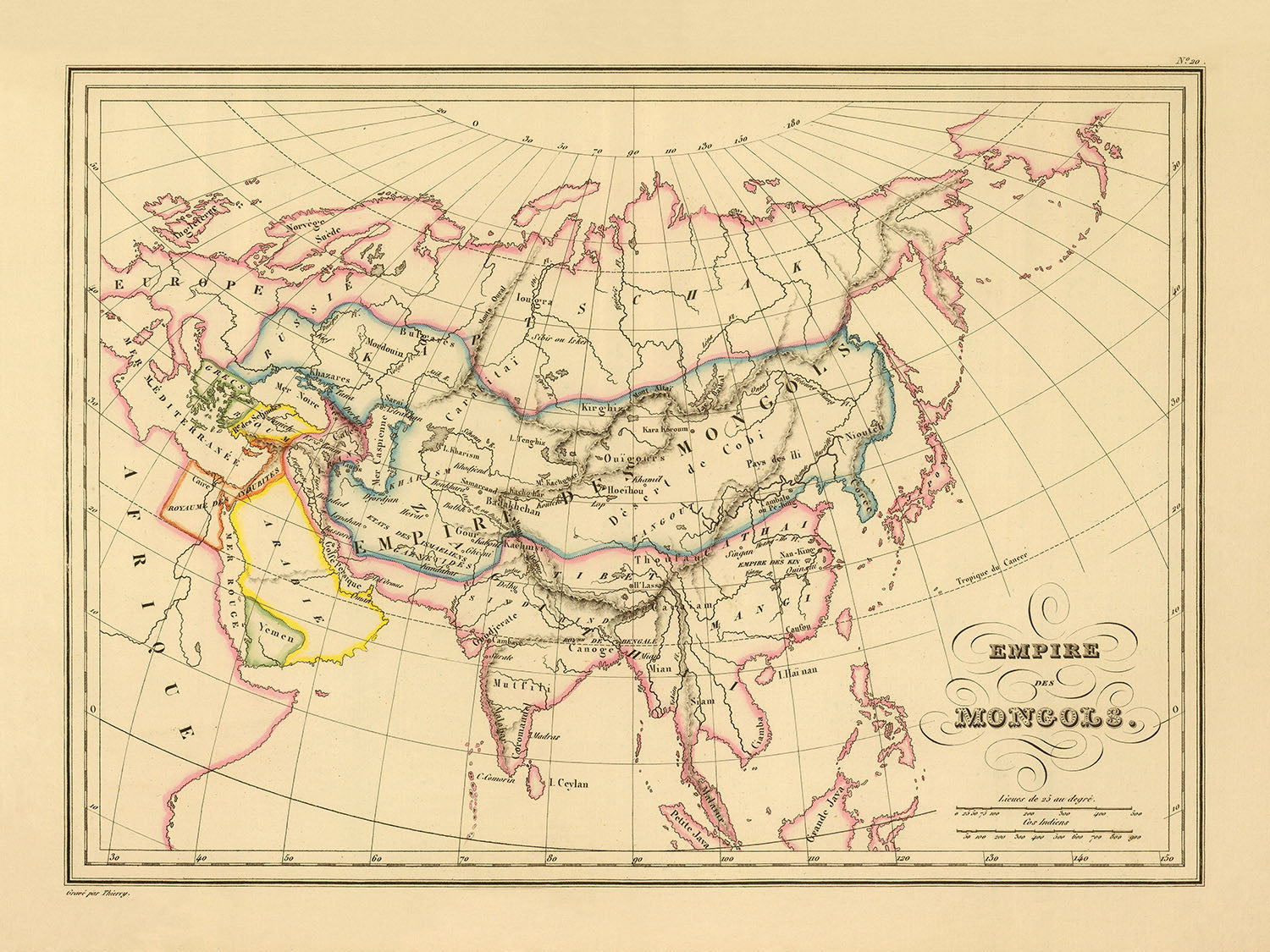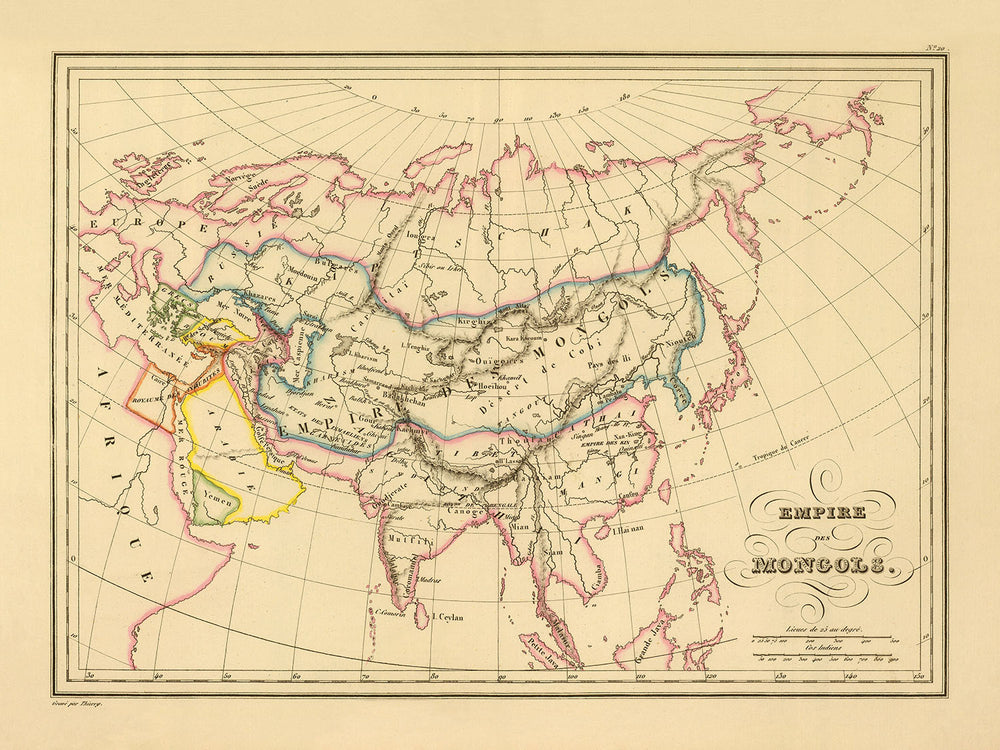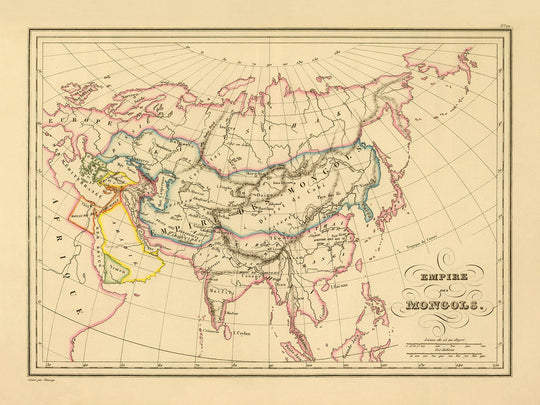- Handmade locally. No import duty or tax
- FREE worldwide delivery
- Love it or your money back (90 days)
- Questions? WhatsApp me any time
Own a piece of history
5,000+ 5 star reviews


Step into the vast expanse of history with the "Empire des Mongols," a meticulously engraved map crafted by the renowned geographer Conrad Malte-Brun in 1837. This map is not merely a geographical representation but a vivid narrative of the Mongol Empire's grandeur, one of the largest empires in human history. Each region is trimmed in distinct colors, highlighting the extensive territories under Mongol control and their neighboring regions. The hand-painted details bring to life the rivers, lakes, islands, and regions, offering a glimpse into the intricate tapestry of the 19th-century world.
The "Empire des Mongols" map is a treasure trove of historical insights, showcasing the geopolitical landscape during the height of Mongol power. It delineates the vast territories from Eastern Europe to East Asia, including significant regions like Persia, India, and China, which were profoundly influenced by Mongol rule.
This map is a testament to the Mongol Empire's strategic prowess, featuring major cities such as Karakorum, the empire's capital. It also marks the territories of the Golden Horde in Russia, the Ilkhanate in Persia, the Yuan Dynasty in China, and the Chagatai Khanate in Central Asia. These regions, each with their unique historical narratives, collectively paint a picture of an empire that was not only vast in its geographical reach but also rich in cultural and political diversity.
The geographical features meticulously engraved on the map, such as the Caspian Sea, the Aral Sea, the Himalayas, and the Gobi Desert, provide a comprehensive understanding of the natural landscapes that shaped the Mongol Empire's expansion and administration. The inclusion of significant rivers like the Indus, Yellow, Amu Darya, and Syr Darya further emphasizes the importance of these waterways in sustaining the empire's vast territories and facilitating trade and communication.
Owning the "Empire des Mongols" map is akin to holding a piece of history, a window into an era when the Mongol Empire redefined the boundaries of the known world. This map is not just a decorative piece but a conversation starter, a scholarly artifact that invites you to explore the historical significance of one of the most formidable empires in history. Its detailed engravings and hand-painted colors make it a luxurious addition to any collection, offering both aesthetic pleasure and intellectual enrichment.
Places on this map
- Karakorum
- Persia
- India
- China
- Caspian Sea
- Aral Sea
- Himalayas
- Gobi Desert
- Golden Horde
- Ilkhanate
- Yuan Dynasty
- Chagatai Khanate
- Kipchak Steppe
- Arabian Peninsula
- Indian subcontinent
- Korean Peninsula
- Japanese archipelago
- Tibetan Plateau
- Indus River
- Yellow River
Notable Features & Landmarks
- The Mongol Empire's vast expanse from Eastern Europe to East Asia
- Major cities such as Karakorum, the capital of the Mongol Empire
- Regions like Persia, India, and China which were influenced by Mongol rule
- The Caspian Sea and the Aral Sea
- The Himalayas
- The Gobi Desert
- The territories of the Golden Horde in Russia
- The Ilkhanate in Persia
- The Yuan Dynasty in China
- The Chagatai Khanate in Central Asia
- The Kipchak Steppe
- The Arabian Peninsula
- The Indian subcontinent
- The Korean Peninsula
- The Japanese archipelago
- The Tibetan Plateau
- The Indus River
- The Yellow River
- The Amu Darya and Syr Darya rivers
- The Caucasus Mountains
- The Ural Mountains
- The Volga River
- The Oxus River
- The Persian Gulf
- The Bay of Bengal
- The Red Sea
- The Mediterranean Sea
- The Black Sea
- The Sea of Japan
Historical and design context
- Name of the map: Empire des Mongols
- Creation date: 1837
- Mapmaker or publisher: Conrad Malte-Brun, a notable geographer and cartographer of the 19th century
- Engraved map: Created using an engraving process, a common technique in the 19th century for producing detailed maps
- Countries trimmed in color: Different countries or regions are outlined and filled with distinct colors for easy differentiation
- Rivers, lakes, islands, and regions shown: Includes detailed geographical features such as rivers, lakes, islands, and various regions
- Includes 2 scales: Provides two scales for measurement, likely to aid in understanding distances and geographical relationships
- Hand-painted: Maps are hand-painted with both outline and full color, adding a unique and artistic touch to each copy
- Historical significance: Focuses on the Mongol Empire, one of the largest empires in history, providing insights into historical geography and the extent of Mongol influence
- Geopolitical context: Illustrates the vast territories under Mongol control and their neighboring regions
- Design or style: Designed in a typical 19th-century cartographic style with detailed engravings and hand-painted colors, reflecting the artistic and scientific standards of the time
Please double check the images to make sure that a specific town or place is shown on this map. You can also get in touch and ask us to check the map for you.
This map looks great at every size, but I always recommend going for a larger size if you have space. That way you can easily make out all of the details.
This map looks amazing at sizes all the way up to 50in (125cm). If you are looking for a larger map, please get in touch.
The model in the listing images is holding the 18x24in (45x60cm) version of this map.
The fifth listing image shows an example of my map personalisation service.
If you’re looking for something slightly different, check out my collection of the best old maps to see if something else catches your eye.
Please contact me to check if a certain location, landmark or feature is shown on this map.
This would make a wonderful birthday, Christmas, Father's Day, work leaving, anniversary or housewarming gift for someone from the areas covered by this map.
This map is available as a giclée print on acid free archival matte paper, or you can buy it framed. The frame is a nice, simple black frame that suits most aesthetics. Please get in touch if you'd like a different frame colour or material. My frames are glazed with super-clear museum-grade acrylic (perspex/acrylite), which is significantly less reflective than glass, safer, and will always arrive in perfect condition.
This map is also available as a float framed canvas, sometimes known as a shadow gap framed canvas or canvas floater. The map is printed on artist's cotton canvas and then stretched over a handmade box frame. We then "float" the canvas inside a wooden frame, which is available in a range of colours (black, dark brown, oak, antique gold and white). This is a wonderful way to present a map without glazing in front. See some examples of float framed canvas maps and explore the differences between my different finishes.
For something truly unique, this map is also available in "Unique 3D", our trademarked process that dramatically transforms the map so that it has a wonderful sense of depth. We combine the original map with detailed topography and elevation data, so that mountains and the terrain really "pop". For more info and examples of 3D maps, check my Unique 3D page.
For most orders, delivery time is about 3 working days. Personalised and customised products take longer, as I have to do the personalisation and send it to you for approval, which usually takes 1 or 2 days.
Please note that very large framed orders usually take longer to make and deliver.
If you need your order to arrive by a certain date, please contact me before you order so that we can find the best way of making sure you get your order in time.
I print and frame maps and artwork in 23 countries around the world. This means your order will be made locally, which cuts down on delivery time and ensures that it won't be damaged during delivery. You'll never pay customs or import duty, and we'll put less CO2 into the air.
All of my maps and art prints are well packaged and sent in a rugged tube if unframed, or surrounded by foam if framed.
I try to send out all orders within 1 or 2 days of receiving your order, though some products (like face masks, mugs and tote bags) can take longer to make.
If you select Express Delivery at checkout your order we will prioritise your order and send it out by 1-day courier (Fedex, DHL, UPS, Parcelforce).
Next Day delivery is also available in some countries (US, UK, Singapore, UAE) but please try to order early in the day so that we can get it sent out on time.
My standard frame is a gallery style black ash hardwood frame. It is simple and quite modern looking. My standard frame is around 20mm (0.8in) wide.
I use super-clear acrylic (perspex/acrylite) for the frame glass. It's lighter and safer than glass - and it looks better, as the reflectivity is lower.
Six standard frame colours are available for free (black, dark brown, dark grey, oak, white and antique gold). Custom framing and mounting/matting is available if you're looking for something else.
Most maps, art and illustrations are also available as a framed canvas. We use matte (not shiny) cotton canvas, stretch it over a sustainably sourced box wood frame, and then 'float' the piece within a wood frame. The end result is quite beautiful, and there's no glazing to get in the way.
All frames are provided "ready to hang", with either a string or brackets on the back. Very large frames will have heavy duty hanging plates and/or a mounting baton. If you have any questions, please get in touch.
See some examples of my framed maps and framed canvas maps.
Alternatively, I can also supply old maps and artwork on canvas, foam board, cotton rag and other materials.
If you want to frame your map or artwork yourself, please read my size guide first.
My maps are extremely high quality reproductions of original maps.
I source original, rare maps from libraries, auction houses and private collections around the world, restore them at my London workshop, and then use specialist giclée inks and printers to create beautiful maps that look even better than the original.
My maps are printed on acid-free archival matte (not glossy) paper that feels very high quality and almost like card. In technical terms the paper weight/thickness is 10mil/200gsm. It's perfect for framing.
I print with Epson ultrachrome giclée UV fade resistant pigment inks - some of the best inks you can find.
I can also make maps on canvas, cotton rag and other exotic materials.
Learn more about The Unique Maps Co.
Map personalisation
If you're looking for the perfect anniversary or housewarming gift, I can personalise your map to make it truly unique. For example, I can add a short message, or highlight an important location, or add your family's coat of arms.
The options are almost infinite. Please see my map personalisation page for some wonderful examples of what's possible.
To order a personalised map, select "personalise your map" before adding it to your basket.
Get in touch if you're looking for more complex customisations and personalisations.
Map ageing
I have been asked hundreds of times over the years by customers if they could buy a map that looks even older.
Well, now you can, by selecting Aged before you add a map to your basket.
All the product photos you see on this page show the map in its Original form. This is what the map looks like today.
If you select Aged, I will age your map by hand, using a special and unique process developed through years of studying old maps, talking to researchers to understand the chemistry of aging paper, and of course... lots of practice!
If you're unsure, stick to the Original colour of the map. If you want something a bit darker and older looking, go for Aged.
If you are not happy with your order for any reason, contact me and I'll get it fixed ASAP, free of charge. Please see my returns and refund policy for more information.
I am very confident you will like your restored map or art print. I have been doing this since 1984. I'm a 5-star Etsy seller. I have sold tens of thousands of maps and art prints and have over 5,000 real 5-star reviews. My work has been featured in interior design magazines, on the BBC, and on the walls of dozens of 5-star hotels.
I use a unique process to restore maps and artwork that is massively time consuming and labour intensive. Hunting down the original maps and illustrations can take months. I use state of the art and eye-wateringly expensive technology to scan and restore them. As a result, I guarantee my maps and art prints are a cut above the rest. I stand by my products and will always make sure you're 100% happy with what you receive.
Almost all of my maps and art prints look amazing at large sizes (200cm, 6.5ft+) and I can frame and deliver them to you as well, via special oversized courier. Contact me to discuss your specific needs.
Or try searching for something!
















































